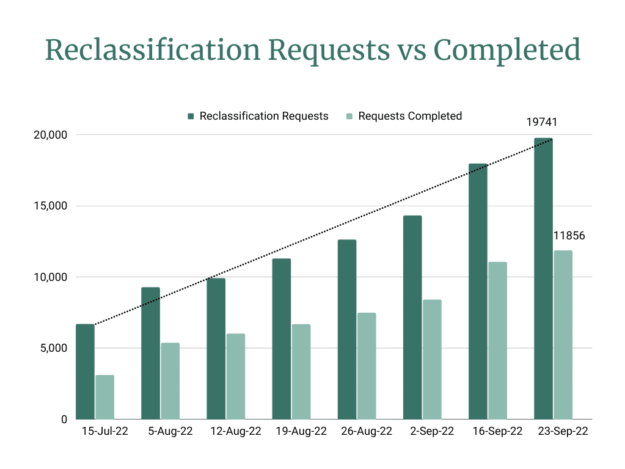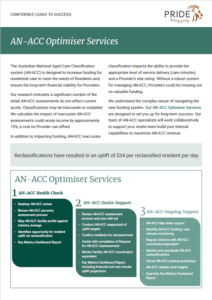In our last AN-ACC Insight, we highlighted the difference in financial outcomes between strong and weak AN-ACC reassessment processes and the need for providers to continually review the AN-ACC classifications of their residents to ensure they obtain the funding they are entitled to. With the benefit of more AN-ACC reassessment data published by the Department, this Insight builds on our previous observations and recommendations.
Department data indicates 13,068 AN-ACC reclassification requests were submitted in the July to September 2022 period, totalling 19,741 requests. This is a significant increase from 6,673 requests made as of July 2022 and confirms the ongoing challenge to ensure AN-ACC classification levels of residents reflect their changing care needs and the impact of the 90% repeatability quality of original assessments.

While identifying residents whose classification needs to be changed is important, this does not resolve the matter. As of September 2022, only 60% of the reclassification requests have been completed. The timeliness of reassessment is important as changed funding only accrues from when the request has been made and successfully reassessed. This is where strong systems that trigger reassessment as early as possible are crucial.

A Strong System
A key feature of a strong system is a low level of:
 false positives – applications that do not result in a reassessment and
false positives – applications that do not result in a reassessment and
false negatives reviews – internal reviews that fail to pick up when a reassessment is appropriate
A system with low levels of false negatives will mean that AN-ACC assessors will develop confidence in your reassessment which is likely to lead to quicker reassessments and reduced workloads for your clinical staff.
Providers should establish a monitoring system that is sensitive in capturing changes in acuity that could trigger a change in AN-ACC assessment so that prompt reclassification requests are made, minimising avoidable delays.

Forgone Funding
Based on our recent analysis, the average value of initial AN-ACC classifications for facilities across most geographic areas is $197.61. Once reclassified residents are taken into account, the average value of reclassified residents increased by 21% to $238.63. This finding is consistent with our calculations in August 2022.
A client who is using Pride Living’s AN-ACC Optimiser Service mirrors these findings. Prior to our review, the average AN-ACC was $201.84. Following our detailed analysis and onsite support, we identified 12 residents (23% of residents) were eligible for reclassification and this lifted the average AN-ACC to $239.78.
The successful reclassification of these residents equates to a $138,481 increase in annualised funding for the provider.
The general analysis and the client specific analysis are shown in the table:

While this appears to be a great outcome for the client, it really demonstrates the need for a robust system and early triggers for reclassification. We will continue to support this provider with regular reviews, and we’ve established policies and protocols with the provider to capture any further change in resident acuity and associated funding.

How we can help
Our Pride Living AN-ACC Optimiser Service gives providers a structured approach that is tailored to meet individual provider needs in analysing AN-ACC data to identify opportunities for increased funding. We focus on ensuring AN-ACC classifications are as accurate as possible, setting providers with the correct baseline, ahead of care minute requirements. We also develop capabilities within teams so that funding and clinical outcomes are sustained.
📝 If you’re into self-assessment, try this exercise:
Calculate what percentage of your residents are in Classifications 11, 12 and 13.
If this is less than 40%, then it’s likely that you are missing out on funding you are entitled to.


